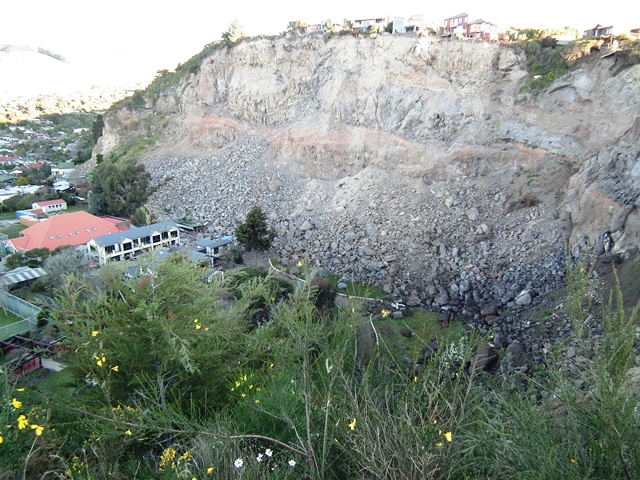5 August 2011
Landslides from the Christchurch earthquakes part 4: large-scale cliff collapses
Posted by Dave Petley
The other parts of this series may be found here:
Part one: boulder damage to a house
Part three: topographic amplification at the cliff tops
Part four: large-scale cliff collapses
Part five: landslides that involve sliding
In the Christchurch earthquakes there were a number of large-scale rock collapses in the areas to the south-east of the city. These events caused a small number of fatalities and considerable damage. At the lower end of the scale were some isolated rock detachments, albeit involving large blocks:
However, the real story is with some very large cliff collapses that have driven retreat of the clifftop by ten metres or more. These two image show two of these very large collapse sites. Note the inundation of the land at the toe of the slopes and the proximity of some buildings to the debris:
The impacts on properties at the top of the cliff has been severe. In some cases, houses have already been partially or completely destroyed as a result of the rockfalls:
In others, blocks that have partially detached, but not yet failed, have opened huge cracks that have profoundly damaged properties. In some cases these blocks extend tens of metres back from the clifftop, leaving a long-term legacy of severe hazard. This house for example has one of these cracks extending through the living room:
This house is also on one such block. The lower part of the house is being pulled apart as it moves:
Meanwhile, this house is entirely on such a block, such that the deformation is occurring in the patio on the road side of the building as the structure is being pulled forwards:
Finally, these cracks of course mean that there is a huge volume if potentially unstable material that threatens roads and buildings at the toe of the slope. As an emergency measure, shipping containers are being used to provide protection:
The next part of this series should follow tomorrow. It will look at conventional landslides triggered by the earthquake. On Monday I will post some images of the ruined city centre.
The other posts in this series are as follows:
Part one: boulder damage to a house
Part three: topographic amplification at the cliff tops
Part four: large-scale cliff collapses
Part five: landslides that involve sliding











 Dave Petley is the Vice-Chancellor of the University of Hull in the United Kingdom. His blog provides commentary and analysis of landslide events occurring worldwide, including the landslides themselves, latest research, and conferences and meetings.
Dave Petley is the Vice-Chancellor of the University of Hull in the United Kingdom. His blog provides commentary and analysis of landslide events occurring worldwide, including the landslides themselves, latest research, and conferences and meetings.
[…] Part four: large-scale cliff collapses […]
[…] Part four: large-scale cliff collapses […]
[…] Part four: large-scale cliff collapses […]
Dave, by chance were those pics at Sumner Beach??
Dan
Here’s a link to a story of a local mudslide affecting the Durango & Silverton Narrow Gauge Railroad.
http://www.durangoherald.com/article/20110804/NEWS01/708039877/-1/News01/Crews-make-headway-on-mudslide
building too near slopes !!!! rock mechanic espalain what happened!!! no study (geomechanics and geologics) before edifications and no urbanistic rules for this in earthquake regions?
Christchurch city was not considered a high earthquake risk – the fault concerned was unknown. Parts of the Canterbury region were always known to be high risk of course – includes the Southern Alps!
[…] Part four: large-scale cliff collapses […]
[…] New Zealand (Christchurch) Landslide cliffs In the Christchurch earthquakes there were a number of large-scale rock collapses in the areas to the south-east of the city. These events caused a small number of fatalities and considerable damage. At the lower end of the scale were some isolated rock detachments. $$$ […]
[…] Part four: large-scale cliff collapses […]
[…] This was the result of a block being detached by work crews seeking to remove loose material generated by the earthquake sequence earlier this year. […]
[…] aftermath of these cliff collapses can be seen in my earlier posts here and […]
[…] a problem. Yahoo News reports that rockfalls have occurred in the bluffs to the east of the city (this is the area that I visited in the summer – and indeed I will be back there in three weeks time) and has this image, which is almost […]
[…] a problem. Yahoo News reports that rockfalls have occurred in the bluffs to the east of the city (this is the area that I visited in the summer – and indeed I will be back there in three weeks time) and has this image, which is almost […]